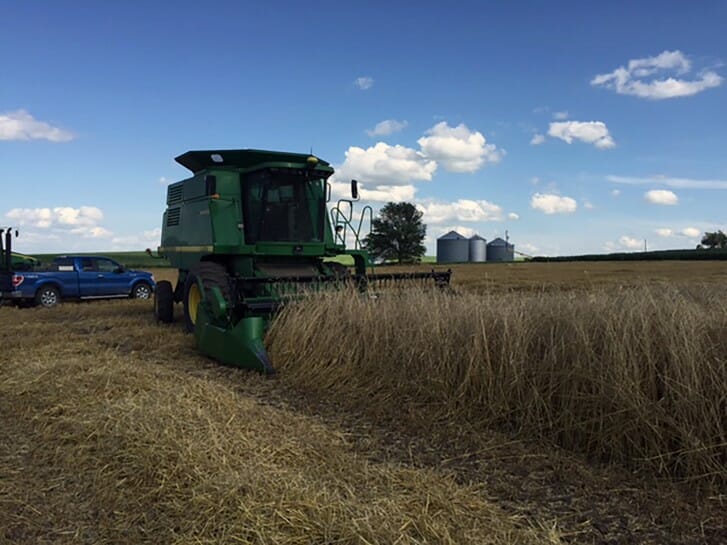The Ditlevson Small Grains Playbook

Mark Ditlevson of Blooming Prairie, MN Photo: Marie Wood. May 10, 2017. “From the fields, May 12: Farmers plant in May sunshine.” The Land Online.
After taking a break in May we got back onto our monthly small grains shared learning call on June 9. One of our pilot program farmers from Blooming Prairie, Minnesota, Mark Ditlevson, took the floor at the beginning of the call to discuss his fungicide and fertilizer regime for his small grains and his set up for harvest, which is right around the corner.
Mark planted 300 acres of small grains to harvest this year. He has both winter small grains (wheat and cereal rye) and spring ones (wheat and oats). All of them were planted after soybeans, an early maturity variety to allow optimum planting date for the winter small grains to maximize winter survival. About half of his acres are already under contract to go to Albert Lea for seed. For the other half he’s aiming for a miller – which means he needs to achieve food grade test weight and protein levels and pass strict toxin tests for diseases and crop protectant residues (particularly herbicides). The following is his playbook for growing a high quality small grains crop that meets seed and milling market specifications.
Field Passes – Fungicides, Herbicides and Growth Regulators
Phil Needham is Mark’s small grains guru. He follows the Needham plan for “managing your way to higher profits” which are modeled after European wheat cultivation techniques that yield 150-200 bushels per acre. This year Mark has done/will do the following field operations:
| Winter Small Grains (wheat, cereal rye) | Spring Small Grains (wheat, oats) | |
| Pre-planting or when over-wintering plants green up | 15 gallons of 32% | 180 lbs P & K, broadcast |
| V4-5 | 7 oz. Palisade® growth regulator and 4 oz. of Quilt® fungicide. | 7 oz. Palisade® growth regulator, 4 oz. of Quilt® fungicide and 2, 4-D |
| Joining, plants 10-12 inches tall |
10-20 gallons of 32% |
|
| Full flag |
10 oz. Headline® fungicide and 7 oz. Palisade® growth regulator |
|
|
Flowering/heading stage |
7-8 oz. fungicide (product TBD) |
|
Mark’s goal is to reach 200 lbs of N total between his applications (~124 lbs) and the N credit from the previous soybean crop. But, Palisade (or another growth regulator) plays a crucial role in how the small grain responds to this high N rate. The regulator forces energy into the small grain head to improve test weight instead of letting the plant send it into longer stalks, which is what would happen naturally with no growth regulator and a high fertilizer rate. Letting the plant send all of its energy into stalks not only lowers test weight, but also increases the likelihood that the plant will lodge or fall down — which makes harvest more challenging.
Harvest Equipment
If the small grains are still upright, they can be harvested directly with a combine. If they have lodged, then combining directly is impossible, you have to first cut and swath the small grains to harvest. Mark hopes that his growth regulator applications will pay off and he can take it standing. To set up his combine for this, Mark adds two sets of filler plates on the concave of his John Deere S670 combine – the same machine he uses to harvest corn and soybeans – and an Active Header height sensor for off-ground, “rigid mode” designed for harvesting small grains.

Jack Boyer setting up to harvesting standing small grains with a combine in 2016, as Mark hopes to this year.
Mark is one of the participants in our cost-share pilot program this year and became a PFI member this week – welcome Mark! If you would like to participate in our small grains pilot program contact alisha@practicalfarmers.org. If you’ve missed the shared learning calls, catch up by reading the blog re-caps on variety selection, grain markets, straw markets and best management practices. Don’t miss our small grains conference in Ames on August 17 – registration is now open at: www.practicalfarmers.org/small-grains.
